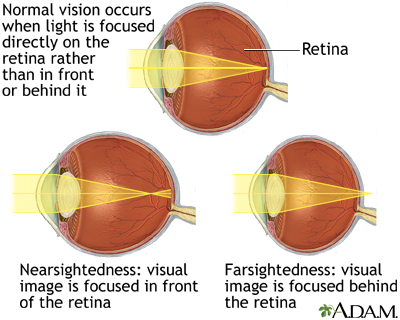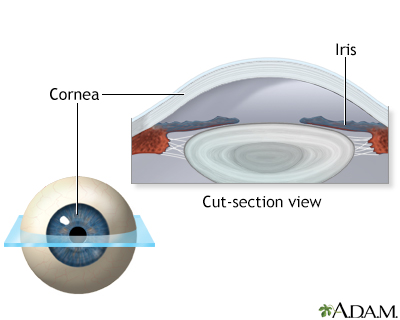Nearsightedness
Myopia; Shortsightedness; Refractive error - nearsightedness
Nearsightedness is when light entering the eye is focused incorrectly. This makes distant objects appear blurred. Nearsightedness is a type of refractive error of the eye.
If you are nearsighted, you have trouble seeing things that are far away.

Visual acuity tests may be performed in many different ways. It is a quick way to detect vision problems and is frequently used in schools or for mass screening. Driver license bureaus often use a small device that can test the eyes both together and individually.

Normal vision occurs when light is focused directly on the retina rather than in front or behind it. A person with normal vision can see objects clearly near and faraway. Nearsightedness results in blurred vision when the visual image is focused in front of the retina, rather than directly on it. It occurs when the physical length of the eye is greater than the optical length. For this reason, nearsightedness often develops in the rapidly growing school-aged child or teenager, and progresses during the growth years, requiring frequent changes in glasses or contact lenses. A nearsighted person sees near objects clearly, while objects in the distance are blurred. Farsightedness is the result of the visual image being focused behind the retina rather than directly on it. It may be caused by the eyeball being too small or the focusing power being too weak. Farsightedness is often present from birth, but children can often tolerate moderate amounts without difficulty and most outgrow the condition. A farsighted person sees faraway objects clearly, while objects that are near are blurred.

The cornea is the transparent part of the eye that covers the iris. It is also the main light bending part of the eye.
Causes
People are able to see because the front part of the eye bends (refracts) light and focuses it on the retina. This is the inside of the back surface of the eye.
Nearsightedness occurs when there is a mismatch between the focusing power of the eye and the length of the eye. Light rays are focused in front of the retina, rather than directly on it. As a result, what you see is blurry. Most of the eye's focusing power comes from the cornea.
Nearsightedness affects males and females equally. People who have a family history of nearsightedness are more likely to develop it. Most eyes with nearsightedness are healthy. However, a small number of people with severe nearsightedness develop a form of retinal degeneration.
The predominant wavelength of light in your environment may affect the development of myopia. Recent research suggests that more time outdoors during childhood may lead to less myopia.
Symptoms
A nearsighted person sees close-up objects clearly, but objects in the distance are blurred. Squinting will tend to make far away objects seem clearer.
Nearsightedness is often first noticed in school-aged children or teenagers. Children often cannot read the blackboard, but they can easily read a book.
Nearsightedness gets worse during the growth years. People who are nearsighted may need to change glasses or contact lenses often. Nearsightedness most often stops progressing as a person stops growing in his or her early twenties.
Other symptoms may include:
- Eyestrain
- Headaches (uncommon)
Exams and Tests
A nearsighted person can easily read the Jaeger eye chart (the chart for near reading), but has trouble reading the Snellen eye chart (the chart for distance reading).
A general eye exam, or standard ophthalmic exam may include:
- Eye pressure measurement (tonometry)
- Refraction test, to determine the correct prescription for glasses
- Retinal examination
- Slit-lamp exam of the structures at the front of the eyes
- Test of color vision, to look for possible color blindness
- Tests of the muscles that move the eyes
- Visual acuity, both at a distance (Snellen), and close up (Jaeger)
Treatment
Wearing eyeglasses or contact lenses can help shift the focus of the light image directly onto the retina. This will produce a clearer image.
The most common surgery to correct myopia is LASIK. An excimer laser is used to reshape (flatten) the cornea, shifting the focus. A newer type of laser refractive surgery called SMILE (Small Incision Lenticule Extraction) is also approved for use in the United States.
Outlook (Prognosis)
Early diagnosis of nearsightedness is important. A child can suffer socially and educationally by not being able to see well at a distance.
Possible Complications
Complications may include:
- Corneal ulcers and infections may occur in people who use contact lenses.
- Rarely, complications of laser vision correction may occur. These can be serious.
- People with myopia, in rare cases, develop retinal detachments or retinal degeneration.
When to Contact a Medical Professional
Contact your health care provider if your child shows these signs, which may indicate a vision problem:
- Having difficulty reading the blackboard in school or signs on a wall
- Holding books very close when reading
- Sitting close to the television
Contact your eye doctor if you or your child is nearsighted and experiences signs of a possible retinal tear or detachment, including:
- Flashing lights
- Floating spots
- Sudden loss of any part of the field of vision
Prevention
It has been generally believed that there is no way to prevent nearsightedness. Reading and watching television do not cause nearsightedness.
During the COVID-19 pandemic of 2020, when most school-aged children were learning from home, there was an increase in the development of nearsightedness over what had been seen before. In the past, dilating eye drops were proposed as a treatment to slow the development of nearsightedness in children, but those early studies were inconclusive. However, there is recent information that certain dilating eyedrops used in certain children at just the right time, may decrease the total amount of nearsightedness that they will develop.
The use of glasses or contact lenses does not affect the normal progression of myopia -- they simply focus the light so the nearsighted person can see distant objects clearly. However, it is important to not prescribe glasses or contact lenses that are too strong. Hard contact lenses will sometimes hide the progression of nearsightedness, but vision will still get worse "under" the contact lens.
References
Le NT, Mamalis C, Weikert MP, Al-Mohtaseb Z. Excimer laser surface ablation: photorefractive keratectomy (PRK), laser subepithelial keratomileusis (LASEK), and Epi-LASIK. In: Yanoff M, Duker JS, eds. Ophthalmology. 6th ed. Philadelphia, PA: Elsevier; 2023:chap 3.3.
Nischal KK. Ophthalmology. In: Zitelli BJ, McIntire SC, Nowalk AJ, Garrison J, eds. Zitelli and Davis' Atlas of Pediatric Physical Diagnosis. 8th ed. Philadelphia, PA: Elsevier; 2023:chap 20.
Olitsky SE, Marsh JD. Abnormalities of refraction and accommodation. In: Kliegman RM, St. Geme JW, Blum NJ, et al, eds. Nelson Textbook of Pediatrics. 22nd ed. Philadelphia, PA: Elsevier; 2025:chap 660.
Stevens DV, Young JA. Correction of refractive errors. In: Yanoff M, Duker JS, eds. Ophthalmology. 6th ed. Philadelphia, PA: Elsevier; 2023:chap 2.4.
Wang J, Li Y, Musch DC, et al. Progression of myopia in school-aged children after COVID-19 home confinement. JAMA Ophthalmol. 2021;139(3):293-300. PMID: 33443542
Version Info
Last reviewed on: 7/9/2024
Reviewed by: Audrey Tai, DO, MS, Athena Eye Care, Mission Viejo, CA. Also reviewed by David C. Dugdale, MD, Medical Director, Brenda Conaway, Editorial Director, and the A.D.A.M. Editorial team.
